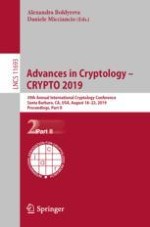2019 | OriginalPaper | Buchkapitel
Non-malleable Secret Sharing in the Computational Setting: Adaptive Tampering, Noisy-Leakage Resilience, and Improved Rate
verfasst von : Antonio Faonio, Daniele Venturi
Erschienen in: Advances in Cryptology – CRYPTO 2019
Aktivieren Sie unsere intelligente Suche, um passende Fachinhalte oder Patente zu finden.
Wählen Sie Textabschnitte aus um mit Künstlicher Intelligenz passenden Patente zu finden. powered by
Markieren Sie Textabschnitte, um KI-gestützt weitere passende Inhalte zu finden. powered by
Abstract
-
Continuous non-malleability: No computationally-bounded adversary tampering independently with all the shares can produce mauled shares that reconstruct to a value related to the original secret. This holds even in case the adversary can tamper continuously, for an unbounded polynomial number of times, with the same target secret sharing, where the next sequence of tampering functions, as well as the subset of shares used for reconstruction, can be chosen adaptively based on the outcome of previous reconstructions.
-
Resilience to noisy leakage: Non-malleability holds even if the adversary can additionally leak information independently from all the shares. There is no bound on the length of leaked information, as long as the overall leakage does not decrease the min-entropy of each share by too much.
-
Improved rate: The information rate of our final scheme, defined as the ratio between the size of the message and the maximal size of a share, asymptotically approaches 1 when the message length goes to infinity.
